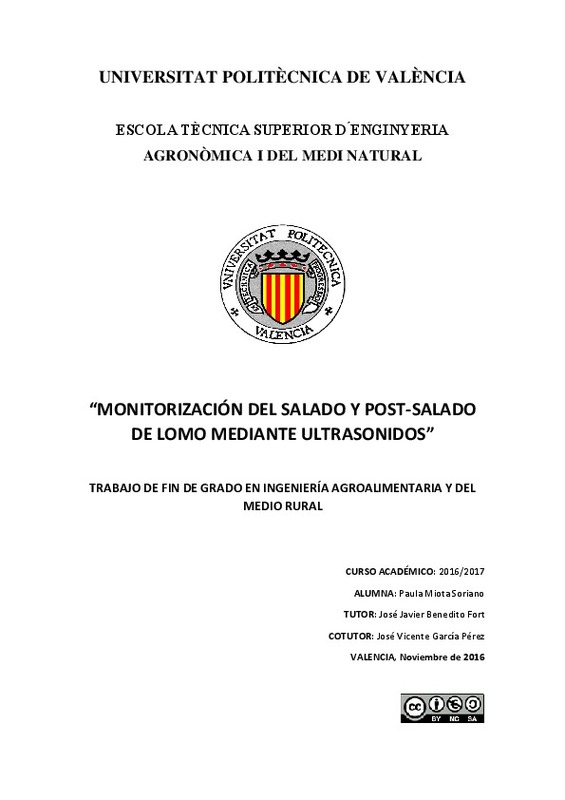|
Resumen:
|
[ES] Dada la gran variabilidad composicional y estructural de la carne, así como de las condiciones
de procesado, el establecer tiempos fijos de salado y post-salado puede dar lugar a una
elevada heterogeneidad en la ...[+]
[ES] Dada la gran variabilidad composicional y estructural de la carne, así como de las condiciones
de procesado, el establecer tiempos fijos de salado y post-salado puede dar lugar a una
elevada heterogeneidad en la calidad final de los productos cárnicos crudo-curados. Las
técnicas que se emplean actualmente para controlar el salado y post-salado de estos
productos implican el uso de métodos destructivos, que analizan el contenido en sal y agua de
la muestra al finalizar el proceso, lo que conlleva que se generalicen los resultados para una
misma partida de carne, en base a un número reducido de muestras analizadas.
El objetivo general de este trabajo fue evaluar la viabilidad de los ultrasonidos de señal como
técnica no destructiva, para caracterizar el proceso de salado y post-salado de carne de cerdo
(Longissimus dorsi, LD) con lo que poder establecer relaciones entre los parámetros
ultrasónicos obtenidos de forma no destructiva de la muestra de lomo (LD) y los cambios en el
contenido y distribución de sal dentro de los lomos durante el salado y post-salado.
Se midió de forma automática el tiempo de vuelo (Tv) cada 5 minutos durante el salado y
post-salado. Se ensayaron 5 tiempos de post-salado (14, 28, 43, 56 y 72 h). Al finalizar el
proceso de post-salado, se determinó el gradiente de sal, de humedad y de dureza entre la
zona externa e interna de los lomos. Por último se establecieron las relaciones entre las
variables composicionales y texturales y el incremento del tiempo de vuelo.
El gradiente de humedad dentro de la pieza de lomo se redujo durante el post-salado llegando
a una situación de equilibrio a las 43 h. Por otro lado, el gradiente de sal también disminuyó,
mostrando una estabilización a las 28 h. En el caso del gradiente de dureza, también se
observó una tendencia descendente con el tiempo de post-salado, aunque la variabilidad
experimental no permitió encontrar diferencias significativas (p>0.05) entre los diferentes
tiempos de post-salado.
La variación del tiempo de vuelo dividida por el tiempo de vuelo inicial (ΔTv /Tv0) disminuyó
con el tiempo de post-salado, estabilizándose a partir de las 43 h de post-salado, lo que,
coincide con el momento en el que dejan de producirse cambios significativos en el gradiente
de sal y de humedad.
Los resultados obtenidos mostraron que los ultrasonidos de señal permiten monitorizar
adecuadamente la etapa de post-salado de Longissimus dorsi (LD), estimando el momento en
el que se estabilizan los cambios composicionales y texturales en la carne.
[-]
[EN] Due to the great compositional and structural variability of the meat as well as the processing
conditions, to establish a fixed time of salting and post-salting lead to a high heterogeneity in
the final quality of ...[+]
[EN] Due to the great compositional and structural variability of the meat as well as the processing
conditions, to establish a fixed time of salting and post-salting lead to a high heterogeneity in
the final quality of the meat dry-cured products. The techniques currently used to control the
salting and post-salting of these products involve the use of destructive methods, which
analyze the salt and water content of the sample at the end of the process, which means that
the results are generalized for the same lot of meat, based on a small number of samples
analyzed.
The main objective of the present work was to determine the viability of using low intensity
ultrasound as a non‐destructive technique to monitor the salting and post-salting process of
pork (Longissimus dorsi, LD) with which to establish relations between the ultrasonic
parameters obtained in a non-destructive way from the loin sample (LD) and changes in the
content and distribution of salt inside the loins during salting and post-salting.
The time of flight was measured automatically every 5 minutes during the salting and postsalting
process. 5 post-salting times (14, 28, 43, 56 and 72 h) were tested. When the postsalting
process finished, the gradient of salt, moisture and hardness were determined
between the external and internal zones of the loins. Finally, the relationships between the
compositional and textural variables and the variation of the time of flight were established.
The moisture gradient inside the loin was reduced during post-salting, reaching equilibrium at
43 h. On the other hand, the salt gradient also decreased, showing stabilization at 28 h. In the
case of the hardness gradient, a downward trend was also observed with the post-salting time,
however, the experimental variability did not allow to find significant differences (p> 0.05)
between the different post-salting times.
The variation of the time of flight divided by the initial time of flight (ΔTv /Tv0) decreased with
the post-salting time, becoming stable after the 43 h of post-salting, which, coincides with the
moment in which significant changes in the gradient of salt and of dampness stop producing.
The results obtained showed that low intensity ultrasounds allow to suitably monitor the
period of post-salting of Longissimus Dorsi (LD), estimating the moment in which
compositional and textural changes in the meat stabilize.
[-]
|







